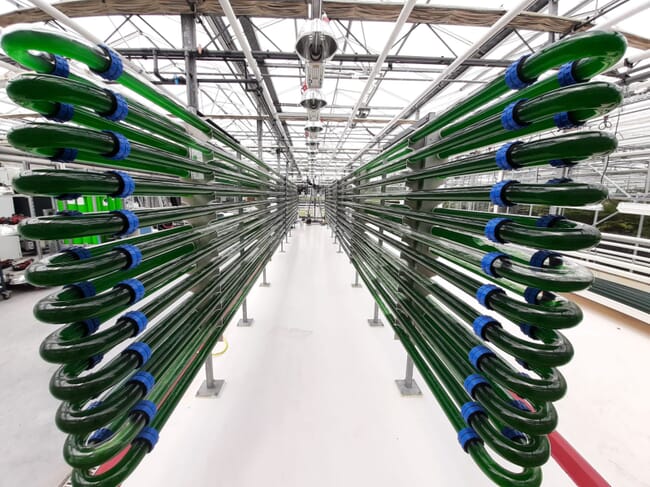
Production of Galdieria sulphuraria in a pilot tubular photobioreactor at AlgaePARC (Wageningen University and Research, The Netherlands)
Galdieria sulphuraria is an extremophile microalga species with blue pigment that can live in extreme conditions and could, they say, represent a resilient source of protein for food and feed.
“This is the first time the nutritional profile of this species has been accurately quantified and understood,” said Pedro Moñino Fernández, PhD student and lead researcher on the EU-funded ProFuture project, in a press release. “We are now closer to real applications of this interesting and unexploited microalga that could have a significant impact on how the world feeds itself.”
The research results represent a key milestone for ProFuture, a project that scales up microalgae production as a sustainable, protein-rich food and feed ingredient.
Galdieria sulphuraria can live in extreme environments that are typically not conducive to life. Although the species has been studied for decades due to its resilience and adaptability, it had not been examined as a possible food source or produced at scale yet. ProFuture studied a strain growing in the hot springs in the Naples region of Italy, and found the following results.
Great potential as an alternative protein
G. sulphuraria biomass was found to have protein content in the range of 62-65 percent, which is relatively high compared to other algal and fungal microorganisms with protein contents ranging from 30-70 percent. In addition, G. sulphuraria proteins have a good amino acid profile, including all essential amino acids. The proteins are especially rich in two amino acids rarely found in such high levels in non-animal-based proteins: cystine and methionine.
A better source of blue pigment
“Microalgae offer some key advantages compared to other microorganisms currently being studied as potential food sources. They are a natural source of essential fatty acids, and species such as G. sulphuraria are among the few naturally occurring sources of blue pigment,” says Iago Dominguez Teles, the project manager at Wageningen University.
G. sulphuraria contains a high concentration of a natural blue pigment commonly used as a colourant in cosmetics and food. This pigment has also been found to have antioxidant properties, as well as potential as a therapeutic agent. Compared to extractions of the already commercially produced microalgae strain Spirulina, the blue pigment extracted from G. sulphuraria demonstrates greater stability, increasing its potential in industrial applications. In addition, a mixotrophic production process is able to increase concentration of the blue pigment.
A scalable production model
The researchers developed an innovative production process using mixotrophy—combining both photosynthesis and sugar-based feedstock to stimulate the growth of microalgae. To further validate the process beyond the bench scale, they could successfully demonstrate pilot production in a 1,300-litre (1.5 cubic metre) bioreactor at Wageningen University.
Next steps
In order to effectively exploit G. sulphuraria, the scientists say that additional research is needed to assess its digestibility and to identify any additional processing methods that may be required for commercial applications. The European Food Safety Authority (EFSA) is currently assessing its safety as a novel food for the general population and as a food supplement for adults. In addition, Blue Galdieria extract is being assessed as a food additive.



